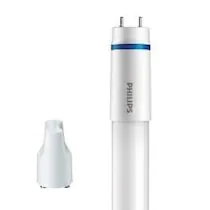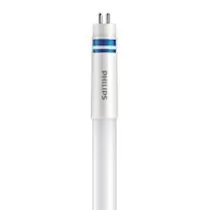LED Tubes
LED tubes are an ideal replacement for conventional fluorescent tubes. They're used in a wide variety of locations with offices, schools, sports halls, sheds and garages being just a few examples. Replacing fluorescent tubes with LED ones saves a lot of energy. You don't even need to change your existing fixtures because there are LED tubes that work with conventional or electronic ballasts. LED tubes made for conventional fixtures come complete with a starter. What's more, they have an extremely long lifespan and low maintenance costs. Check your current light fixtures and tubes carefully and use the filters on the left to select the product(s) you require. If you want to replace your fixture(s) too, take a look at our LED panels or LED battens.
Show more
Popular and related categories
Filter inCategory
Too much choice?
Find the product in 3 steps!
Help me choose!
Current refinements:
Only in Stock
Product Type Category
Explanation
This filter allows you to refine your search by selecting specific types of light sources. Choose from options such as LED bulbs, LED tubes, or LED spots to find the perfect lighting solution for your needs.
Length
Explanation The most common lengths for T8 LED Tubes are 60cm, 90cm, 120cm and 150cm. For T5 LED Tubes this concerns 55cm, 85cm, 115cm and 145cm. Switching to LED? Then always check the length of your current fluorescent lighting. Do you want to know more? Then read our blog!
The most common lengths for T8 LED Tubes are 60cm, 90cm, 120cm and 150cm. For T5 LED Tubes this concerns 55cm, 85cm, 115cm and 145cm. Switching to LED? Then always check the length of your current fluorescent lighting. Do you want to know more? Then read our blog!
 The most common lengths for T8 LED Tubes are 60cm, 90cm, 120cm and 150cm. For T5 LED Tubes this concerns 55cm, 85cm, 115cm and 145cm. Switching to LED? Then always check the length of your current fluorescent lighting. Do you want to know more? Then read our blog!
The most common lengths for T8 LED Tubes are 60cm, 90cm, 120cm and 150cm. For T5 LED Tubes this concerns 55cm, 85cm, 115cm and 145cm. Switching to LED? Then always check the length of your current fluorescent lighting. Do you want to know more? Then read our blog!
Ballast for LED Tubes
Explanation
A ballast can be seen as an energy regulator that switches on the lighting. Is there a starter in the fixture? Then this is a conventional ballast (EM). Fixtures with an electronic ballast (HF) don't have a starter. A LED driver can be compared to an electronic ballast and only works with LED lighting.
Colour Code
Explanation The colour code is a combination of colour rendering (CRI) and light colour (Kelvin). The first number indicates the colour rendering (1 = very poor colour rendering, 9 = maximum colour fastness). The second and third number contains the light colour. Example: the colour code 830 consists of good colour rendering (8) and warm white light (3000K).
The colour code is a combination of colour rendering (CRI) and light colour (Kelvin). The first number indicates the colour rendering (1 = very poor colour rendering, 9 = maximum colour fastness). The second and third number contains the light colour. Example: the colour code 830 consists of good colour rendering (8) and warm white light (3000K).
 The colour code is a combination of colour rendering (CRI) and light colour (Kelvin). The first number indicates the colour rendering (1 = very poor colour rendering, 9 = maximum colour fastness). The second and third number contains the light colour. Example: the colour code 830 consists of good colour rendering (8) and warm white light (3000K).
The colour code is a combination of colour rendering (CRI) and light colour (Kelvin). The first number indicates the colour rendering (1 = very poor colour rendering, 9 = maximum colour fastness). The second and third number contains the light colour. Example: the colour code 830 consists of good colour rendering (8) and warm white light (3000K).
Colour temperature (Kelvin)
Explanation

Light colour options
Explanation
The colour control type tells you in which way you can regulate the colour of the light. You have the following options:
1. Single colour: This light has one fixed light colour. You cannot change it.
2. CCT: You choose from 2 or 3 fixed colours via a switch, such as warm white or cool white.
3. Tunable white: The white light can take any values in the listed Kelvin scale, for instance 2200K up to 6500K.
4. Dim to warm: Dimming makes the light warmer (more yellow). The more you dim, the warmer the colour.
5. RGB: You can set the light to almost any colour. From red to blue, you fill it in completely as you wish.
By choosing your preferred light colour options, you are one step closer to the right light product.
Colour of Light
Explanation
The light color indicates the color of the light emitted: white, colored, or UV. For many products in our assortment, the light is white, available in a range from very warm white to daylight white (expressed in Kelvin). With colored light, you have two options: 1. A single fixed color, such as red or green. 2. RGBW, which means you can adjust the light color at any time: white or colored.
Brand
Replaces (Watt)
Explanation
This indicates which wattage of your old/conventional lighting is replaced by this LED product.
LED Tube Output
Explanation
High Output - Gives higher lumen output vs standard tube
Standard Output - average lumen output
Ultra Output - Highest Lumen out, ceiling must be over 4 metres
High Efficiency - High lumen lumen / watt ratio
Ultra Efficiency - LED tubes with best energy label (A + B)
Standard Output - average lumen output
Ultra Output - Highest Lumen out, ceiling must be over 4 metres
High Efficiency - High lumen lumen / watt ratio
Ultra Efficiency - LED tubes with best energy label (A + B)
Luminous Flux (Lumen)
Explanation
The number of lumens (lm) is the light output of a light source. The higher the number of lumens, the more light the light source emits. The wattage and the number of lumens are not connected to each other. An LED lamp with a low wattage can have a higher number of lumens than a conventional lamp with a high wattage.
Cap / Base
Explanation
The cap/base of a bulb is the part that connects it to the socket in the fixture. E27 (Edison screw) and E24 (small Edison screw) caps/bases are among the most popular, although this depends on your location. GU10 is generally the most common cap/base for spotlights. Check which cap/base you need carefully as many other types are also available.
Any Lamp all-in warranty
Explanation
Our all-in warranty is fully included in the product price and covers both hidden defects and technical defects of the product that occurred before delivery. The warranty period differs per product and ranges from 1 year to a maximum of 7 years.
Energy efficiency class
Explanation Every bulb or fixture has an energy efficiency class A to G. Energy label A is the most efficient and G the least. LED lighting is the most sustainable lighting technique. Even if a LED bulb is rated E or lower, they still save 70% of energy compared to conventional lighting with the same energy label. Why is it the same label then? To motivate LED brands to get even more durable.
Every bulb or fixture has an energy efficiency class A to G. Energy label A is the most efficient and G the least. LED lighting is the most sustainable lighting technique. Even if a LED bulb is rated E or lower, they still save 70% of energy compared to conventional lighting with the same energy label. Why is it the same label then? To motivate LED brands to get even more durable.
 Every bulb or fixture has an energy efficiency class A to G. Energy label A is the most efficient and G the least. LED lighting is the most sustainable lighting technique. Even if a LED bulb is rated E or lower, they still save 70% of energy compared to conventional lighting with the same energy label. Why is it the same label then? To motivate LED brands to get even more durable.
Every bulb or fixture has an energy efficiency class A to G. Energy label A is the most efficient and G the least. LED lighting is the most sustainable lighting technique. Even if a LED bulb is rated E or lower, they still save 70% of energy compared to conventional lighting with the same energy label. Why is it the same label then? To motivate LED brands to get even more durable.
LED Starter included
Explanation
You need a LED starter if the fluorescent lighting in your current fixture also contains a starter. In that case, you have a fixture with a conventional ballast (EM). A LED starter replaces your current starter and ensures that a LED tube works.
Product Line
Housing
Dimmable
Explanation
Dimmable bulbs work in combination with a dimmer switch and allow you to determine the desired light output. Dimming also provides energy saving potential because less power is required when the lamp is producing less light.
Colour temperature (Kelvin)
Explanation

Colour Code
Explanation The colour code is a combination of colour rendering (CRI) and light colour (Kelvin). The first number indicates the colour rendering (1 = very poor colour rendering, 9 = maximum colour fastness). The second and third number contains the light colour. Example: the colour code 830 consists of good colour rendering (8) and warm white light (3000K).
The colour code is a combination of colour rendering (CRI) and light colour (Kelvin). The first number indicates the colour rendering (1 = very poor colour rendering, 9 = maximum colour fastness). The second and third number contains the light colour. Example: the colour code 830 consists of good colour rendering (8) and warm white light (3000K).
 The colour code is a combination of colour rendering (CRI) and light colour (Kelvin). The first number indicates the colour rendering (1 = very poor colour rendering, 9 = maximum colour fastness). The second and third number contains the light colour. Example: the colour code 830 consists of good colour rendering (8) and warm white light (3000K).
The colour code is a combination of colour rendering (CRI) and light colour (Kelvin). The first number indicates the colour rendering (1 = very poor colour rendering, 9 = maximum colour fastness). The second and third number contains the light colour. Example: the colour code 830 consists of good colour rendering (8) and warm white light (3000K).Show products
Too much choice?
Help me choose!
Current search
913-863 out of 863
results found
Filter
Sort by
LED tubes are an ideal replacement for conventional fluorescent tubes. They're used in a wide variety of locations with offices, schools, sports halls, sheds and garages being just a few examples. Replacing fluorescent tubes with LED ones saves a lot of energy. You don't even need to change your existing fixtures because there are LED tubes that work with conventional or electronic ballasts. LED tubes made for conventional fixtures come complete with a starter. What's more, they have an extremely long lifespan and low maintenance costs. Check your current light fixtures and tubes carefully and use the filters on the left to select the product(s) you require. If you want to replace your fixture(s) too, take a look at our LED panels or LED battens.
Show more




